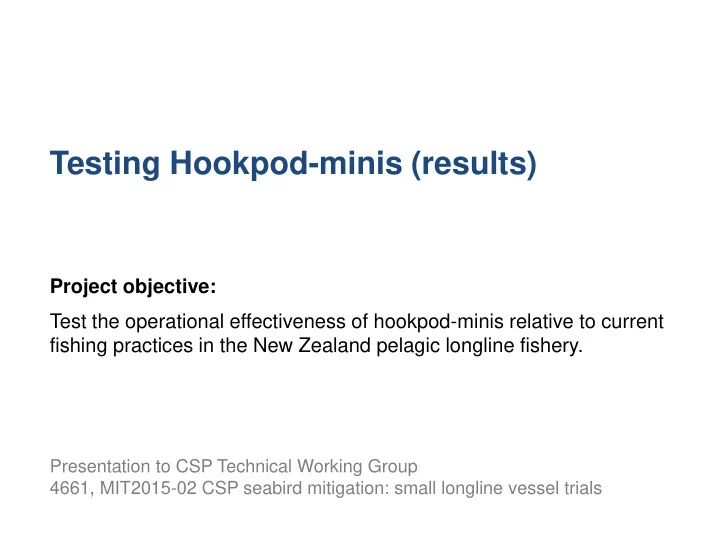

Testing Hookpod-minis (results) Project objective: Test the operational effectiveness of hookpod-minis relative to current fishing practices in the New Zealand pelagic longline fishery. Presentation to CSP Technical Working Group 4661, MIT2015-02 CSP seabird mitigation: small longline vessel trials
Background - hookpod Hookpod design
Background - the fleet 1 set a day, mostly at night, occasionally pre-dusk. 800 - 1200 hooks per day 15 - 30 nautical miles Floating gear, lots floats, long snoods. Winter - bluefin target Summer - bigeye / swordfish
Hookpod-mini opening depth tests Two separate tests: Test 1: dropped 100 pods to 10 m and 15 m Some open after drop to 10 m, all open at 15 m Test 2: dropped 100 pods to 7 m, 10 m, and 15 m with 3 repeats All closed after drop to 7 m
Catch comparison methods Two separate trials, Hookpod-minis on half the gear Vessel A • Hookpod-mini vs unweighted gear, both with tori • Sept 2016 • Bigeye target • East coast North Island Vessel B • Hookpod-mini (no tori) vs 60 g sliding GloLeads (tori most sets) • 60 – 30% GloLeads luminous • July 2017 • Bluefin target • West coast South Island
Catch comparison – raw data
Catch comparison statistical analysis Numbers of tuna similar, but lower numbers of blue shark in hook pod treatments. But lots of variation between sets and between treatments Paired t-tests conducted for each vessel separately resulted in no significant difference between catch rates of: • Tuna, or • Blue shark, or • All sharks On control and hookpod-mini gear.
Catch rate comparison all tuna Vessel B Vessel A
Catch rate comparison blue shark Vessel B Vessel A
Long term performance data collection • Skipper – collected data • 10 months fishing • Results could vary between boats / skippers • Good indication of what is possible • Skipper is happy working them long term
Long term Hookpod-mini performance Per 1000 Totals deployments Number of sets 110 Number of pods set 38152 Number of control snoods set 52404 Number of pods not open 147 3.9 Number of pods open but hook not released 14 0.08 Number of pods lost 201 5.3 Number of pods damaged 40 0.86 Dead birds returned on hook pod gear 3 0.079 Dead birds returned on normal gear 13 0.248
Operational characteristics Not slowing down setting operation Slightly more potential for tangles but hard to quantify and still workable If they are in the gear they will get used More incentive to recover pods than weights (cost) Flexibility for skippers • Distance from hook • Can add lights / lightsticks separately Depends on skipper’s attitude and style of fishing Fly backs were recorded for pods and weighted gear.
Sink rate data • Separate snoods (13 m) • Deployed during normal fishing sets • TDRs 0.5 m from hook • Baited hooks (squid) • Not an absolute measure of true sink rate, but an unbiased comparison • ‘Traditional’ measure: hook protection depends on sink rate, speed and tori line length (assumes tori deployed and effective) • Not so relevant for pods as hook is protected to depth
Hookpod-mini vs unweighted gear, vessel A
Hookpod-mini vs 60 g at 1 m, vessel B
Hookpod-mini vs 38g at 0.5 m vs 60 g at 1 m, vessel C
Lots of variation (vessel B)
Tabulated sink rate data
Next steps Feedback please Final write up Continue long term data collection
Acknowledgements Owners, skippers and crew Jo Potts (statistician) DOC CSP and MPI (special permit) Funding through levy on relevant fish stocks (STN SWO BIG)
Recommend
More recommend